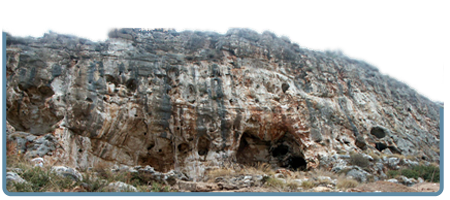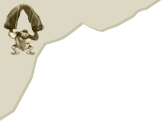Mount Carmel, Israel



 -Carmel, slightly to the south of Nahal (Wadi) Sefunim, at an elevation of ca. 90m, some 12 km south of Haifa.
-Carmel, slightly to the south of Nahal (Wadi) Sefunim, at an elevation of ca. 90m, some 12 km south of Haifa.
Today the site appears to be a rock shelter or an overhang, carved into the rudistic reefal cliff. However, its form, together with remnants of enclosing walls, the ancient flowstones and the numerous boulders along the slope, suggests that it is a large collapsed cave. The cliff at Misliya, facing W/SW, is about 17-20 m high.
rudistic reefal cliff. However, its form, together with remnants of enclosing walls, the ancient flowstones and the numerous boulders along the slope, suggests that it is a large collapsed cave. The cliff at Misliya, facing W/SW, is about 17-20 m high.
 The anthropogenic usage of Misliya Cave is closely associated with ancient caves at the cliff face and their gradual collapse during the retreat of the cliff. The human occupation apparently occurred before, during and after some major collapse events, which occurred through the mid-late Pleistocene. Some of the collapsed debris appears to have rolled some distance down the talus at the foot of the cliff.
The anthropogenic usage of Misliya Cave is closely associated with ancient caves at the cliff face and their gradual collapse during the retreat of the cliff. The human occupation apparently occurred before, during and after some major collapse events, which occurred through the mid-late Pleistocene. Some of the collapsed debris appears to have rolled some distance down the talus at the foot of the cliff.
Strongly cemented archaeological sediments (breccia) are found on three terrace-like surfaces at the base of the cliff and all slope gently to the  west (henceforth Upper, Middle and Lower
west (henceforth Upper, Middle and Lower  Terraces). Vertical natural exposures within the breccia separate the terraces. Their relationships to the various stages of cave collapse are not fully understood. The surface of the Lower Terrace is located about 10 m below that of the Upper Terrace.
Terraces). Vertical natural exposures within the breccia separate the terraces. Their relationships to the various stages of cave collapse are not fully understood. The surface of the Lower Terrace is located about 10 m below that of the Upper Terrace.
 In the eastern part of the Upper Terrace, brecciated layers pass laterally into softer sediments, forming an area of about 15m², which is more amenable to excavation. Within the main excavated area on the Upper Terrace, both the upper part of the breccia and the soft sediments contain abundant lithics from the Levatine Mousterian of Tabun D type together with a rich faunal assemblage (Weinstein-Evron et al. 2003; Bar-Oz et al. 2005; Yeshurun et al., 2007).
In the eastern part of the Upper Terrace, brecciated layers pass laterally into softer sediments, forming an area of about 15m², which is more amenable to excavation. Within the main excavated area on the Upper Terrace, both the upper part of the breccia and the soft sediments contain abundant lithics from the Levatine Mousterian of Tabun D type together with a rich faunal assemblage (Weinstein-Evron et al. 2003; Bar-Oz et al. 2005; Yeshurun et al., 2007).
 The bottom of the Middle Paleolithic layers was so far attained in a limited area where the soft sediments were
The bottom of the Middle Paleolithic layers was so far attained in a limited area where the soft sediments were found lying above an old rockfall containing a mixture of Acheulo - Yabrudian and Mousterian finds, which yielded the largest sample of handaxes from the site (Zaidner and Weinstein -Evron 2006).
found lying above an old rockfall containing a mixture of Acheulo - Yabrudian and Mousterian finds, which yielded the largest sample of handaxes from the site (Zaidner and Weinstein -Evron 2006).
While the cultural affinity of the finds on the Middle Terrace could not have been determined to date, Middle Paleolithic layers cover an extensive  surface of the Upper Terrace, most notably in its central/northern portion.
surface of the Upper Terrace, most notably in its central/northern portion.
The Lower Terrace, where Acheulo-Yabrudain finds constituted the only existing cultural unit (Weinstein-Evron et al. 2003), yielded a small lithic assemblage rich in handaxes and Acheulo-Yabrudian side-scrapers.
Digging into the breccia was sometimes devastating since the extraction of the bones and lithics was almost impossible.
of the bones and lithics was almost impossible.
This is especially true at the Lower Terrace, where we excavated about 2.5 cubic meters of the hardest breccia at the site. So far this is only a place at the site that yielded sterile Acheulo-Yabrudian assemblage.
 The digging of breccia layers was executed by electric hummers, hummers and chisels. The extracted chunks of breccia were then carefully broken at the lab to extract lithic and bones.
The digging of breccia layers was executed by electric hummers, hummers and chisels. The extracted chunks of breccia were then carefully broken at the lab to extract lithic and bones.
Although we faced some difficulties excavating breccia layers, the results were rewarding. Breccia was found to be rich in bones and lithics and raised some challenging questions, for example what processes are responsible for creating the bones and lithics pockets that occur in various lacations at the site.
were rewarding. Breccia was found to be rich in bones and lithics and raised some challenging questions, for example what processes are responsible for creating the bones and lithics pockets that occur in various lacations at the site.
 Unlike difficulties experienced facing the breccia, digging of the soft sediments is really enjoyable. The state of preservation of bones and lithics is trully amazing. The artifacts appear as dense living floors
Unlike difficulties experienced facing the breccia, digging of the soft sediments is really enjoyable. The state of preservation of bones and lithics is trully amazing. The artifacts appear as dense living floors which also include rich evidence of use of fire. Refitting of fire-exploded artifacts together with preservation of hearths provides evidence for in-situ preservation of human living floors in soft sediments area.
which also include rich evidence of use of fire. Refitting of fire-exploded artifacts together with preservation of hearths provides evidence for in-situ preservation of human living floors in soft sediments area.
- Bar-Oz, G., Livne, P., Zaidner, Y. And Weinstein-Evron, M. 2005. Fragments of
Information: Preliminary Taphonomic Results from The Middle Palaeolithic
Breccia Layers Of Misliya Cave, Mount Carmel, Israel (9th Icaz Conference,
Durham 2002). O'connor, T. (Ed.) Biosphere to Lithosphere: New Studies in
Vertebrate Taphonomy. Oxford: Oxbow Books. Chapter 13: 126-134.
- Garrod, D.A.E and Bate, D.M.A. 1937. The Stone Age of Mount Carmel. Vol. I.,
Excavations at the Wadi Mughara. Oxford, Clarendon Press.
- Jelinek, A.J., W.R. Farrand, G. Haas, A. Horowitz and P. Goldberg, 1973. New
Excavations At The Tabun Cave, Mount Carmel, Israel, 1967-1972: A Preliminary
Report. Paleorient 1: 151-183.
- Weinstein Evron, M. And Tsatskin, A. 1994. The Jamal Cave Is Not Empty: Recent
Excavations In The Mount Carmel Caves, Israel. Paléorient 20: 119-128.
- Weinstein-Evron, M., Bar-Oz, G., Zaidner, Y., Tsatskin, A., Druck, D., Porat, N.
and Hershkovitz, I. 2003. Introducing Misliya Cave, Mount Carmel, Israel: A New
Continuous Lower/Middle Paleolithic Sequence in the Levant. Eurasian Prehistory 1(1): 31-55.
- Yeshurun R., G. Bar-Oz and M. Weinstein-Evron in press. Modern hunting behavior in the early Middle Paleolithic: Faunal remains from Misliya Cave, Mount Carmel, Israel. Journal of Human Evolution. Available online August 1, 2007.
- Zaidner, Y. Druck, D. Nadler, M. And Weinstein-Evron, M. 2005. The
Acheulo-Yabrudian Of Jamal Cave, Mount Carmel, Israel. Journal of the Israel
Prehistoric Society 35: 93-116.
- Zaidner, Y. Druck, D. And Weinstein-Evron, M. 2006. Acheulo-Yabrudian Handaxes from Misliya Cave, Mount Carmel, Israel. In: N. Goren-Inbar And G. Sharon (Eds.) Axe Age: Acheulian Tool-making from Quarry to Discard. London, Equinox, pp. 243-266.


